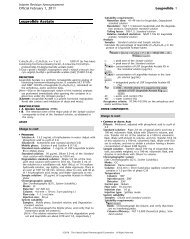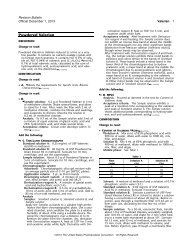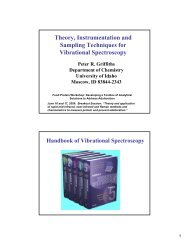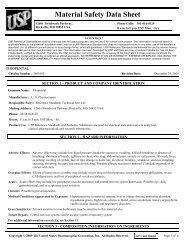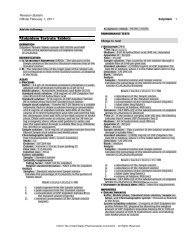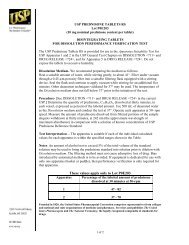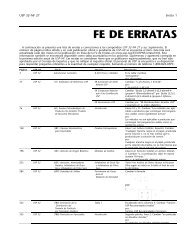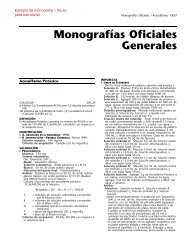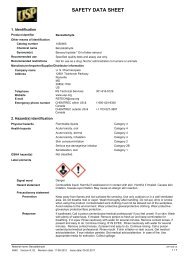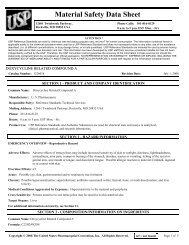Promote Safe Medication Use - US Pharmacopeial Convention
Promote Safe Medication Use - US Pharmacopeial Convention
Promote Safe Medication Use - US Pharmacopeial Convention
You also want an ePaper? Increase the reach of your titles
YUMPU automatically turns print PDFs into web optimized ePapers that Google loves.
Revision BulletinOfficial October 1, 2010 〈1066〉 Physical Environments 3levels, and to optimize their performance. Adjustable features in-clude provision of a work station that is protected from interrup-tions and distractions, such as a separate medication room, or a mo-bile cart with work space for those that are not adversely affectedby distractions. Individuals have different levels of distractibility—workers should be sensitive to their own need for a distraction-freework area (19). Heightened worker awareness of the adverse impactof interruptions and distractions can help minimize problems.Workers can be trained in how to avoid interrupting coworkers fornonurgent reasons, while their coworkers are performing medica-tion-related tasks. Coworkers asking for assistance were found tobe the most frequent source of interruptions in a pharmacy study(19). Techniques to decrease interruptions and distractions includevisual cues (such as wearing orange safety vests), physical barriers(e.g., preparing doses in a medication room) and the use of checkl-ists that assist attention focus or refocus (38). <strong>Medication</strong> safetyzones should be located in areas where the potential for distractionand interruption is minimized.of 80 or more) to assist with proper medication checking (29). Tasklighting can help achieve appropriate levels of lighting and shouldbe included on mobile medication carts (including those used withbar code medication verification systems). Glare should be controlledby ensuring that light reflections that can wash out thescreen and make it difficult to read are not visible in computermonitors (29).Illumination levels for medication rooms located on nursing unitsshould be at least 1000 lux (100 fc) based on the complexity of thetask, reading small type font on medication packages, and the needfor accuracy and speed (28, 44). The higher range of the lightinglevel should be used when the task requires reading small print.Lighting level recommendations are summarized in Table 1. Lightinglevels can decrease by 25% over a 2-year period, so it is importantthat lighting fixtures are cleaned routinely to maintain recommendedluminance levels. Lighting levels should be measured on aquarterly basis. Burned out or flickering bulbs should be promptlyreplaced (29).Proper lighting is also essential at the point of care. Attemptingto be patient- and family-friendly may run contrary to the necessarylighting conditions for safe medication administration. Administrationof medication at night under low luminance to avoid disturbingthe patient or family is an unsafe practice. Task or spot lightingmust be available, so that visual confirmation of the correct patient(reading armband), medication, and administration site is notcompromised.Sound and NoiseThe Environmental Protection Agency (EPA) recommends peaksound levels of 45 dB during the day and 35 dB at night in hospitals(10). The World Health Organization (WHO) guidelines state thatbackground sound levels in a patient room should not exceed 35 dB(5). The International Noise Council recommends 45 dB during theday and 20 dB at night for acute care areas (10). Ear protection isInterruptions and Distractions required when workers are exposed to sound levels averaging 90dB.The standard for sound levels in medication safety zones is set atthe level of conversation, 50 dBA. This is intended to ensure thatcritical verbal information can be heard accurately (7). Healthcareproviders should be sensitive to their individual need for quiet, de-pending on the task being performed, and they should have a quietarea available to promote accurate performance. The total elimina-tion of noise in patient-care settings is not feasible or desirable. Pa-tient counseling areas in pharmacies should include sound-reduc-tion methods to enhance audibility and learning—for example, useof a closed room.Noise is recognized as a serious health hazard to hospitalized pa-tients, and as an interference with effective work performance.Most studies of the effects of noise in the work environment havebeen conducted in non-healthcare settings. However, noise levels asa contributing factor of stress for nurses is increasingly being docu-mented. In healthcare facilities, sources of noise can range fromoverhead paging systems, equipment alarms, heating, ventilation,air-conditioning (HVAC) systems, plumbing, televisions, radios,and ice machines (5). Noise has been cited as one obstacle to theeffective performance of nurses (23). An in-depth study developeda noise map of a hospital, and found sound levels of 55 dB, which is10-20 dB above EPA recommendations, depending on the time ofday. Average sound levels in other hospitals have been measuredWorkplace designers need to be keenly aware of the significantimpact that interruptions and distractions can have on accurate patientcare, so that they design workspaces to counter these effects.Distraction from competing tasks is likely to impair performance inseveral ways, such as sensory/perceptual interference (you don’thear the alarm because a coworker interrupts with a question), cognitivecost of switching tasks (you respond to an alarm more slowlybecause it takes time to reorient to the alarmed task after a coworker’squestion), or prospective memory failure (you forget to performa step because you forget where you left off when returning to thetask after interruption). Countermeasures may address some or allof these problems (e.g., use of checklists). Nurses frequently citedistractions and interruptions as contributing to the incidence ofmedication errors (27, 51, 52). Interruptions and distractions havebeen associated with higher prescription dispensing error rates in anambulatory pharmacy (19). According to the 2008 <strong>US</strong>PMEDMARX Data Report, distractions continue to rank high (approximately45%) as contributing to medication errors in hospitalsand health systems (27).Interruptions and distractions can be prevented by providing staffwith the ability to control and manage their exposure to these disturbances.Workers can be allowed to adjust features of the medicationsafety zone to maximize their concentration and attentionTable 1. Lighting Level Recommendations for Healthcare SettingsIllumination LevelFoot-CandleWork Area Lux (fc)Computer order entry (44, p. 408) 1000 100Handwritten order processing (44, p. 408) 1000 100<strong>Medication</strong> filling and checking (pharmacy) (8, 20) 900–1500 90–150Patient counseling (pharmacy) (8, 20) 900–1500 90–150Sterile compounding and preparation (8) 1000–1500 100–150Pharmacy medication storeroom (29) 500 50<strong>Medication</strong> preparation area, e.g., nursing station (2) 1000 100<strong>Medication</strong> administration work area (e.g., cart surface, patient room) (2) 1000 100© 2010 The United States <strong>Pharmacopeial</strong> <strong>Convention</strong> All Rights Reserved.
Revision Bulletin4 〈1066〉 Physical Environments Official October 1, 2010between 45–68 dB, with peaks between 85–90 dB (50). A study of due to increased noise levels and distractions when critical life-andsoundlevels during shift changes measured 113 dB (15).death medications are in use.The following sound related features may affect accuracy when One critically important medication safety zone for nurses is thedispensing medication: predictability; controllability (16); type of medication preparation and administration area, which should betask (simple vs. complex) (6); multitasking; distraction due to noise analogous to the cockpit of an airplane. Information must be readily(which may mask environmental cues and the worker’s internal available and user-friendly in order to increase ease of informationvoice, used to rehearse and recall important tasks) (39, 40). Out of synthesis. Access to medication-related information should be effi-58 studies, 7 showed that noise improved performance, while 29 cient, with materials and records readily available at the proper sitesshowed that it impaired performance (21). Unpredictable but con- (i.e., drug information and patient-specific information used totrollable sounds and noise were found in one study to improve pre- make a decision about drug administration should be near eachscription filling accuracy, contrary to previous research (18). This other to support fact finding) (2). Information and componentsmay indicate that some environmental stimuli are needed to main- within the space should be arranged according to specific principlestain proper alertness and attention of workers. Researchers are at- that promote correct choices and decrease distractions when seekingtempting to identify optimal levels of arousal due to sound and information.noise for people performing different kinds of tasks (e.g., Yerkes- As described in the human factors literature (45), these principlesDodson law) (54).include the following:Noise and other sensory interference can be reduced by employ- Importance Principle—Important components should be placeding activities, tools, and principles developed by human factors and in convenient locations. This includes information systems nearengineering experts—many of these principles are already being the medication safety zone so that lab results, drug information,used by some healthcare organizations. The effect of these and vital signs, and pertinent patient information are readily obotherdesign characteristics of nursing workspaces on patient out- tained. Information regarding equipment function and troublecomesand facility performance are being studied as part of a re- shooting should be located near or on the equipment to providesearch project (http://www.pebbleproject.org/pebble_data.php) clarification or a quick answer to questions that arise.sponsored by the Center for Health Design, a nonprofit research and Frequencies of <strong>Use</strong> Principle—Items that are used frequentlyadvocacy organization, and a network of 11 healthcare providers. are easily found and accessible. This prevents “workarounds,”The project reported decreases in medical errors, as well as de- in which alternate equipment is used as a substitute.creases in patient transfers, nosocomial infections, patient falls, and Function Principle—Items that are related to a function aremedication usage (49). When permitted by infection control guide- grouped together. Examples include syringes, needles, and allines,reducing noise by installing materials that absorb sound (e.g., cohol swabs; and IV tubing and connectors that are used inceiling and wall materials, and carpeting) can be accomplished at preparation of infusions. It is important to ensure that approprimodestcost. Acoustical engineers can provide additional methods ate supply levels are maintained and that product expirationfor noise reduction. Workers, who don’t have to respond to any au- dates and applicable storage conditions (e.g., temperature-sensidiblesignals such as telephone calls or alarms, may be able to wear tive products) are routinely checked.noise-canceling headphones and listen to music, provided that per- Sequence of <strong>Use</strong> Principle—Items are placed in an order thatformance is not adversely affected.supports the sequence needed to perform the task correctly,(e.g., sterile gloves are in or with sterile dressing kits; needlelessPhysical Design and Organization of Work Spaceconnectors are with the IV administration sets; and epiduralmedications and epidural supplies are all in one place).Methods for workplace analysis are available (31). Bedside med-Ergonomic design of the workplace environment can influence ication administration areas should follow the same design as thethe ability of providers to effectively utilize information and accu- centralized medication safety zone. Distractions are an even greaterrately perform tasks (2). Counter height, height of supplies, and challenge at the bedside, and measures should be taken to minimizelighting changes in lower drawers and cabinets that decrease visibil- them whenever possible. Information and supplies should followity of products can contribute to errors if improperly adjusted. The the same principles and be placed in an uncluttered area with adeprovisionof adjustable fixtures and counter heights can improve ef- quate lighting. Sharps containers should be placed within easy reachficiency as well as safety. Work counter clutter is typically an indi- and out of high-traffic areas. Each bedside work station should becator of disorganization and a lack of sufficient space to perform standardized in design, so that information and supplies do not needkey tasks. One study found that more dispensing errors occurred to be relocated when moving from one patient bed to another.when medication storage containers were placed on shelves in a The incorporation of lean operation techniques to enhance desiraclutteredfashion (less than one inch between distinct drugs) (20). ble, value-added activities and eliminate the undesirable, often in-Older workers have more difficulty discriminating between differ- visible activities that result in waste in the work process is one apentitems on a cluttered work surface, which is an important consid- proach to workspace redesign (1). An efficient and effectiveeration given the increasing average age of nurses (35).workplace is less conducive to errors. Lean operational techniquesthat eliminate waste and improve timeliness include the following:<strong>Medication</strong> <strong>Safe</strong>ty Zones• Visual Controls: keeping work processes and indicators inview to allow everyone to understand the status of the worksystem at a glance.A medication safety zone is defined as a critical area where• Streamlined Layout: optimizing the sequencing of workmedications are prescribed, orders are entered into a computer orprocesses through facility design.transcribed onto paper documents, and where medications are pre-• Point-of-<strong>Use</strong> Storage: locating supplies, equipment, informapared,dispensed, or administered. Examples include the work surtion,and procedure rules in convenient easily-accessible locafaceof a medication cart on a nursing unit, any location where pretions(37).scribing decisions are made, the work surface of an automatedSimplifying and standardizing the patient-care environment andmedication dispensing device, a pharmacy where prescriptions areequipment decreases the cognitive load, making slips and lapsesprepared, inspected, and dispensed and patient homes where medilesslikely to occur during routine tasks by minimizing decision andcations are prepared, administered or consumed. The patient’s bedmanipulationtime (37). Standardization can be used for facilityside in a hospital is another important medication safety zone thatand room design, medical equipment (e.g., IV infusion devices),presents unique challenges. The physical environment of the operatandmedication areas (e.g., medication delivery and storage of paingroom during surgery is an area that deserves special attentiontient-specific medications). Ensuring ready access to clinical infor-© 2010 The United States <strong>Pharmacopeial</strong> <strong>Convention</strong> All Rights Reserved.
Revision BulletinOfficial October 1, 2010 〈1066〉 Physical Environments 5mation, both patient-specific and medication-related, is essential for tient safety: The SEIPS model. Quality and <strong>Safe</strong>ty in Healthall areas in which steps in the medication-use process occur.Care. 2006;15(Suppl 1):i50-i58.Another medication safety zone design approach is to involve 13. Carayon-Sainfort, P. A balance theory of job design forworkers in innovating solutions to work station problems. There is stress reduction. International Journal of Industrial Ergoaneed to incorporate flexibility into medication safety zone design nomics. 1989; 4 : 67-79.in order to support worker innovation (41).14. Charness N & Dijkstra K. Age, luminance and print legibil-<strong>Medication</strong> safety-related tools and technologies, such as auto- ity in homes, offices and public places. 1999, Human Facmateddrug dispensing devices with point-of-care bar code verifica- tors, 41 (2), pp. 173-193.tion and an integrated electronic medication record, can decrease or 15. Cmiel, CA. Karr, DM. Gasser, DM. Oliphant, LM. Neveau,avert medication errors. Constraint and forcing functions are an ef- AJ. Noise control: A nursing team’s approach to sleep profectivemeans of reducing error, particularly for high-risk medica- motion. American Journal of Nursing. 104(2); 2004. 40–48.tions and situations. The simplest of these do not require technol- 16. Cohen, S. Environmental load and the allocation of attenogy.For example, sealing neuromuscular blockers in an intubation tion. In: A. Baum, J.E. Singer, & S. Valins (Eds.), Advanceskit lessens the chance of a paralyzing agent being administered to a in environmental psychology, Vol. 1. Hillsdale, NJ:patient without a means of ventilation support. An enteral product Erlbaum. 1978.that is physically unable to connect to an intravenous tubing luer 17. ECRI Institute and The Institute for <strong>Safe</strong> <strong>Medication</strong> Praclockconnector would avert a wrong route error, even if the nurse tices (ISMP). Patient <strong>Safe</strong>ty Advisory, June, 2005.was working in low-light conditions and initially misidentified the 18. Flynn, EA. Barker, KN. Gibson, JT. Pearson, RE. Smith,intended route for the tubing (46).LA. Berger, BA. Relationships between ambient sounds andThe availability of medication safety technology is never a sub- the accuracy of pharmacists’ prescription-filling perforstitutefor safe medication practices within a medication safety mance. Human Factors 1996; 38(4): 614–622.zone. Reports have warned of errors as a result of ignoring or over- 19. Flynn, EA. Barker, KN. Gibson, JT. Pearson, RE. Berger,riding safety checks such as smart infusion pump drug libraries and BA. Smith, LA. Impact of interruptions and distractions onalarms (42).dispensing errors in an ambulatory care pharmacy. AmericanJournal of Health-System PharmacyREFERENCES1999;56(13):1319–1325.20. Flynn, EA. Dorris, NT. Holman, GT. Carnahan, BJ. Barker,KN. <strong>Medication</strong> dispensing errors in community pharmacies:1. Alukal, G. Create a lean, mean machine. Quality Progress A nationwide study. 46th Annual Meeting of the Human36(4):29–35, cited in IOM Report “Keeping Patients <strong>Safe</strong>” Factors and Ergonomics Society; 2002 10/2; Baltimore, MD:2003. Human Factors and Ergonomics Society; 2002.2. Alvarado, CJ. The physical environment in healthcare. 21. Gawron, VJ. Performance effects of noise intensity, psy-Carayon P, ed. Handbook of human factors and ergonomics chological set, and task type and complexity. Human Facinhealthcare and patient safety. Mahwah, NJ: Lawrence tors. 24: 1982. 225–243.Erlbaum Associates, 2007; 287–307.22. Grasha, AF. Psychosocial factors, workload, and risk of3. ASTM International. Standard specification for labels for medication errors. U.S. Pharmacist 2002; 27(4): HS32,small-volume (100 mL or less) parenteral drug containers. HS35-HS36,HS39,HS43-HS44,HS47-HS48,HS52.ASTM International D4267-95 (2001). West Conshohocken, 23. Gurses, AP. Carayon, P. Performance obstacles of intensivePa: American Society for Testing and Materials. care nurses. Nursing Research 2007; 56(3): 185–94.4. Bayo MV, Garcia AM, Garcia A. Noise levels in an urban 24. Helander, M. The human factors profession. In: Salvendyhospital and workers’ subjective responses. Arch Environ G, ed. Handbook of Human Factors and Ergonomics. NewHealth. 1995;50 : 247-52. York: John Wiley & Sons. 1997. pp. 3–17.5. Berglund, B. Lindvall, T. Schwela, DH. Guidelines for 25. Hickam, DH. Severance, S. Feldstein, A. Ray, L. Gorman, P.community noise. World Health Organization: Protection of Schuldheis, S. Hersh, WR. The effect of healthcare workingthe Human Environment. 1999.conditions on patient safety. Rockville, MD: Oregon Health6. Broadbent, DE. Decision and stress. New York: Aca- & Science University; 2003 April. Report No.: AHRQ Evidemic.1971. dence Report/Technology Assessment Number 74.7. Bub, B. Friesdorf, W. Ergonomics; Noise and alarms in 26. (http://webmm.ahrq.gov/case.aspx?caseid=93 accessed 9/2/healthcare—an ergonomic dilemma. In: Carayon P., ed. 2007).Handbook of human factors and ergonomics in healthcare 27. Hicks, RW. Becker, SC. Cousins, DD. eds. (2008) <strong>US</strong>Pand patient safety. Mahwah, NJ: Lawrence Erlbaum Associ- MEDMARX data report. A report on the relationship of drugates, 2007; 347–363.names and medication errors in response to the Institute of8. Buchanan, TL. Barker, KN. Gibson, JT. Jiang, BC. Pearson, Medicine’s call for action. Rockville, MD: Center for theRE. Illumination and errors in dispensing. American Journal Advancement of Patient <strong>Safe</strong>ty, U.S. Pharmacopeia.of Hospital Pharmacy 1991; 48(10):2137–45.28. IESNA. IES Lighting Ready Reference. 2nd ed. New York:9. Burrows, AA. Acoustic noise: An informational definition. Illuminating Engineering Society of North America; 1989.Human Factors 1960; 2 : 163.29. IESNA Committee for Healthcare Facilities. Lighting for10. Cabrera, IN. Lee, MHM. 2000. Reducing noise pollution in hospitals and healthcare facilities. New York: Illuminatingthe hospital setting by establishing a department of sound: A Engineering Society of North America; 2006.survey of recent research on the effects of noise and music in 30. International Ergonomics Association. http://www.iea.cc/healthcare. Preventive Medicine. 30 : 339–345. browse.php?contID=what_is ergonomics. August, 2000.11. Carayon, P. Alvarado, C. Hundt, A. Center for Quality and Accessed May 28, 2009.Productivity Improvement and Department of Industrial En- 31. Luczak, H., Kabel, T., & Licht, T. 2005. Task design andgineering, University of Wisconsin-Madison. Reducing Wor- motivation. In G. Salvendy (Ed.), Handbook of human fackloadand Increasing Patient <strong>Safe</strong>ty through Work and tors and ergonomics (3rd ed., pp. 384–427). New York:Workspace Design. Paper commissioned by the Institute of Wiley.)Medicine Committee on the Work Environment for Nurses 32. MayoClinic.com. Presbyopia. http://www.mayoclinic.com/and Patient <strong>Safe</strong>ty. 2003. health/presbyopia/DS00589/ DSECTION=1. Accessed 10/12. Carayon, P. Hundt, AS. Karsh, B-T. Gurses, AP. Alvarado, 30/2007.CJ. Smith, M. Brennan, PF. Work system design for pa-© 2010 The United States <strong>Pharmacopeial</strong> <strong>Convention</strong> All Rights Reserved.
Revision Bulletin6 〈1066〉 Physical Environments Official October 1, 201033. Megaw, ED. Bellamy, LJ. Illumination at work. Oborne, 45. Sanders, MS. McCormick, EJ. Human Factors in Engineer-DJ. Gruneberg, MM. editor. The Physical Environment at ing and Design. New York: McGraw-Hill; 1993.Work. New York: John Wiley & Sons; 1983. p. 109–141. 46. Simmons, D. Phillips, MS. et al. Error-avoidance recommen-34. Murdoch, Joseph B. Illumination Engineering From Edis- dations for tubing misconnections when using luer-tip conon’sLamp to the Laser, Second edition, Visions Comm., nectors: a statement by the <strong>US</strong>P <strong>Safe</strong> <strong>Medication</strong> <strong>Use</strong> Expert1994. Committee. The Joint Commission Journal May 2008;35. Noy, YI. Karwowski, W (eds.). Handbook of Human Factors 34(5):293–296.in Litigation. 2004. Section 11–6.47. Smith, M.J. and Carayon-Sainfort, P. A balance theory of job36. Oborne, DJ. Gruneberg, MM. The environment and produc- design for stress reduction. International Journal of Industivity:An introduction. In: Oborne, DJ. Gruneberg, MM. edi- trial Ergonomics, 1989, vol. 4, pp. 67-79.tor. The Physical Environment at Work. New York: John 48. Spath, P. 2000. Reducing errors through work system im-Wiley & Sons; 1983. p. 1–9.provements. In: Spath P, ed. Error Reduction in Healthcare.37. Page, A. ed. 2004. Institute of Medicine: Keeping Patients San Francisco, CA: Jossey Bass. pp. 199–234.<strong>Safe</strong>: Transforming the Work Environment of Nurses 49. The Center for Health Design. 2003b. Pebble Project: Se-(2004). The National Academy of Sciences, all rights re- lected Preliminary Data. http://www.pebbleproject.org/pebserved,2001.ble_data.php.38. Pape, TM. Guerra, DM. Muzquiz, M. et al.: Innovative ap- 50. Ulrich, R. Zimring, C. The role of the physical environmentproaches to reducing nurses’ distractions during medication in the hospital of the 21st Century: A once-in-a-lifetime opadministration.Journal of Continuing Education in Nursing portunity. Concord, CA; 2004 September.2005; 36(3): 108–16; quiz 141–2. 51. Wakefield, B. Wakefield, D. Uden-Holman, T. Blegen, M.39. Poulton, EC. A new look at the effects of noise: A rejoin- 1998. Nurses’ perceptions of why medication administrationder. Psychological Bulletin. 85; 1978. 1068–79. errors occur. MEDSURG Nursing 7(1):39–44.40. Poulton, EC. 1979. Composite model for human perfor- 52. Walters, J. 1992. Nurses’ perceptions of reportable medicamancein continuous noise. Psychological Review. 86; tion errors and factors that contribute to their occurrence. Ap-361–75. plied Nursing Research 5(2):86–88.41. Roth, E. et al 2006, Evolvable work-centered support sys- 53. Womack, JP. Jones, DT. Lean Thinking. Simon & Schuster:tems for command and control, Ergonomics, 49 (7), 688-705 New York. 1996.42. Rothschild, JM. Keohane, CA. Cook, EF. et al.: A controlled 54. Yerkes, RM. Dodson, JD. 1908. The relation of strength oftrial of smart infusion pumps to improve medication safety in stimulus to rapidity of habit-formation. Journal of Comparcriticallyill patients. [see comment]. Critical Care Medicine ative Neurology and Psychology 18 : 459-482.2005; 33(3): 533–40. • (RB 1-Jun-2010)43. Sanders, MS. McCormick, EJ. Human factors and systems. ■1S (<strong>US</strong>P33)Human Factors in Engineering and Design. New York: Mc-Graw-Hill; 1987. p. 5.44. Sanders, MS. McCormick, EJ. Illumination. Human Factorsin Engineering and Design. New York: McGraw-Hill; 1987.p. 408.© 2010 The United States <strong>Pharmacopeial</strong> <strong>Convention</strong> All Rights Reserved.



